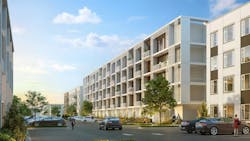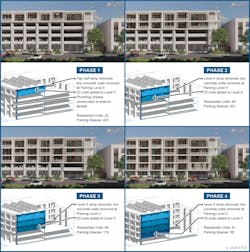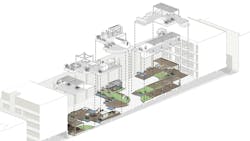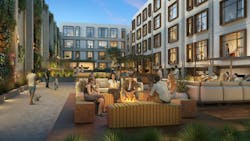Modular adaptive reuse of parking structure grants future flexibility
What do Buffalo, N.Y.; Hartford, Conn.; and San Jose, Calif., have in common? Beginning with Buffalo in 2017, all have abolished parking minimums as a requirement for new residential development. Last November, Austin, Texas, followed suit, eliminating parking requirements for new development, with an exception for accessible parking.
The shift away from excessive parking requirements aligns with a broader movement, encouraging development of more sustainable and affordable housing. According to engineering firm WGI, a single parking space in a parking structure costs roughly $28,000—an additional expense many households would choose to forego, if given the opportunity.
With rising housing costs outpacing salary increases, renters and homeowners alike are looking for solutions that reduce their housing expenses. Separating the cost of parking from housing provides flexibility for managing tight household budgets.
Adaptive Reuse of Parking Structure into new Multifamily Community
Changes in jurisdictional parking requirements provide opportunities for reduced cost of future housing, but residential buildings developed over the last 20 years may already experience the burden of excess parking resulting from past requirements. Particularly in transit-oriented communities, oversized parking structures may be underused.
Additionally, many communities have seen recent expansions of mass transit systems, further decreasing the need for personal vehicles. From Loudon County, Va., outside of Washington, D.C., to the suburbs of Seattle, Wash., new and planned expansion of transit services provide much-needed connectivity, evolving previously car-dependent neighborhoods into transit-oriented communities.
With consideration for changes in driving habits, as well as the widespread concern for housing costs, KTGY’s Research and Development Studio designed a housing concept in 2017 that proposed adaptive reuse of a free-standing parking structure adjacent to a multifamily wrap building. The design concept, Park House, suggested converting underutilized parking into residential units using modular construction.
The concept studied modification to the existing parking structure, addition of residential units, and appropriate construction sequencing. The Park House concept addressed many common adaptive reuse challenges, such as modifications to the structural system and incorporation of utilities, using a complete-conversion approach, with all construction occurring within a single modification timeline.
After discussing this strategy with multifamily developers and operators, complete conversion seemed difficult to justify when only a portion of the garage was unused. While cities pull back on parking requirements rapidly, driving habits change more gradually.
In 2023, with feedback from experts in the industry, KTGY’s Research and Development Studio created an alternative solution for converting underutilized parking to residential using a phased approach. Park House 2.0 proposes an adaptive reuse solution that converts a single floor of underutilized parking at a time, leaving room for further conversion in the future, as market demands shift.
Park House 2.0 Adaptive Reuse Process
Beginning with an existing wrap-building garage from a KTGY project in San Jose, Calif., Park House 2.0 proposes removing the highest level of the parking ramp and inserting wood-framed residential units into the flat portions of that level. The central ramp, now encircled by units, becomes a community courtyard.
Modular platforms create flat areas for outdoor amenity programming along a walkway winding down the existing ramp. Utility chases constructed vertically along the exterior façade during the initial phase of conversion resolve potential conflicts between utilities and remaining lower-level parking.
Structural modifications also take place during the initial phase of conversion, replacing shear walls adjacent to the parking ramp with brace and moment frames, accounting for the future addition of units in those locations.
As residents require fewer parking spaces, the next highest level of the parking ramp is removed and wood-framed units are added, plugging in to the pre-built utility chases. The modular platforms on the sloped amenity ramp shift down to the next lower level of the garage ramp, bringing the amenity courtyard to the lowest residential level.
The Goal of Flexibility
Over the last few years, housing trends have driven residential architecture to incorporate more and more flexibility—in interior unit design, in amenity space functionality, and in ownership options. Increased flexibility can help housing reach a wider demographic and adapt to cultural shifts. But if the goal of incorporating flexibility is to add value for stakeholders, taking a step back and examining flexibility in adaptive reuse solutions creates additional value for underutilized spaces now, and for the future.




